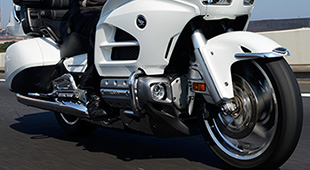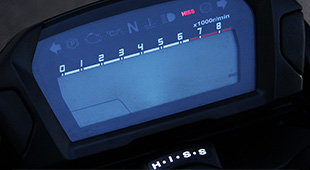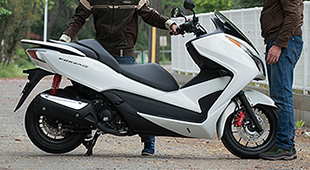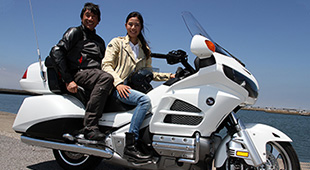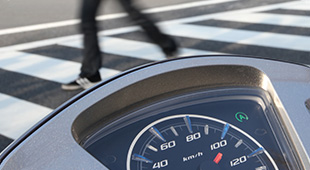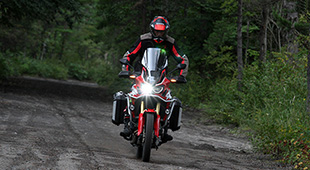Tech Views — Vol. 2 Advanced Brake Systems
PCX
Combined Brake System Road-Testing the PCX
Honestly, These Brakes Are Awesome!
Having had quite an interest in Honda's interlinked front-and-rear wheel brakes for small bikes and scooters, I tested out the PCX, a popular new scooter model equipped with the Combined Brake System. This linked system is not only featured as standard equipment on most of Honda's production scooters, but also on many of its wide range of on-road motorcycles, as well. In the case of the PCX, a squeeze of its left-side brake lever simultaneously applies measured amounts of braking force to both the front and rear wheels.
"Well, isn't that obvious?" Many car drivers might naturally think that to be the case, since when you press your foot down on the brake pedal in a car, it applies brake pressure to all four wheels at the same time. Nothing special there.
However, in the case of motorcycles, with their independently controlled front and rear brakes, it is common for riders to vary their control of the two brakes to best meet the needs of rapidly changing road and riding conditions. Honda's Combined Brake System, on the other hand, manages to distribute a highly effective balance of braking force to both wheels when simply squeezing the rear brake lever.
Can't this also be accomplished using both the front and rear brakes in the normal fashion? Yes, of course it can. However, besides freeing a rider from the effort and, some might say, complication involved in that dual operation, another feature of the Combined Brake System is that it also generates an ideal balance of braking control to both wheels to smoothly, easily and almost automatically achieve braking forces on par with the most expert riders, and all with only the simple squeeze of one hand.
Another feature you should be aware of is that the rear brake seems to engage slightly earlier than the front brake, and this slight difference in brake application timing makes a significant contribution to that superb braking response.
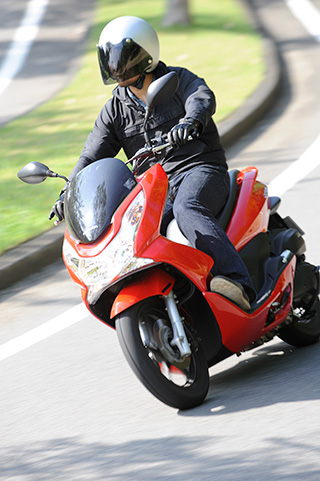
To achieve an optimum rate of deceleration when the brakes are applied using only the left lever, braking force is concentrated on the rear brake while a portion of its pressure is fed to one of the front brake caliper's three pistons. This doesn't, however, mean that the front and rear brakes work at exactly the same time. One of the other big advantages of the Combined Brake System is that this division of the braking force is tuned to match each model's riding conditions depending on the machine's class, weight and character.
For this test I took the PCX for a ride around the crowded streets of central Tokyo. Such superb braking capability combined with the sporty convenience of the PCX's lively 125cc engine to allow me to fully enjoy the ride through the city's often dense traffic all the way to my destination. Considering the time it can often take to walk to a station and transfer between trains, I find it hard to relax when using the subways and buses of Tokyo's extensive rapid transit system. So the fact that I can ride a motorcycle every day brings a little savored enjoyment to my commutes.
If I wanted to take full advantage of the mobility provided by this class of bike, like many Tokyo riders I'd likely be making better use of those gaps between cars as my 'express' lanes, where loose dirt and fallen leaves often pile up. Even over such uneven road surfaces, the response from these brakes is nothing short of amazing.
When using the PCX's Combined Brake System, I found myself also using only the left-side (rear) brake lever while rounding curves or adjusting my following distance behind the vehicle ahead. Since that one lever seemed to deliver ample braking force to both wheels, the PCX trimmed off speed in a remarkably stable manner. If stronger braking control was ever needed, an easy squeeze of the right-side front brake lever provided more than ample force to slow me down in a hurry.

If I were to use only the left-hand rear brake on a regular scooter not equipped with this brake system, the rear tire would lose its grip with the road long before it ever produced any significant braking force, and then just lock up the wheel in a slide. With the PCX's Combined Brake System, operating only the left-hand lever provided an impressive sensation of braking force, as if a big hand was grabbing me from behind, and I never seemed to be able to lock-up the rear tire.
From this description you might think that the Combined Brake System is really only a riding safety device. Less experienced riders might also say, "That kind of braking can be easily done by operating the brakes with both hands, as they're designed, so I'm sure it would be better for me as a rider to do this on my own, rather than relying on a 'crutch' like this one that Honda has made."
I'd probably have the same opinion if I were 17 years old. In fact, when younger, I used to find it quite easy to lock-up the rear brake and slide the rear-end into alleys and such. Which isn't to say that brake systems are made to be used for such riding stunts. However, when you suddenly find yourself in a dangerous situation that causes you to scream "Look out!," this brake system will quickly reveal its full potential almost the instant you squeeze its brake levers.
People generally don't have the capacity to control the brakes in a delicate manner when faced with a sudden and unexpected situation. I've had those experiences myself. And while it could never be said that equipping a bike with the Combined Brake System will automatically prevent accidents, it can at least increase the chances of maintaining some semblance of stability when a rider indelicately grabs a big handful of brakes in a wide-eyed hurry.
With conventional motorcycles, one of the core fundamentals of riding is being able to independently control the front and rear brakes in a well-balanced manner. However, this can be more difficult than one might expect. To what extent braking force should be applied to maintain that optimum balance between front and rear wheels largely depends on long hours of actual riding experience. Since the Combined Brake System puts these basics of braking control into astoundingly easy reach, I found I was able to use the brakes in a much more relaxed manner.
Keep in mind, however, that riders who start out on bikes equipped with Honda's Combined Brake System, and never have much experience riding other motorcycles, may mistakenly take such superb braking capabilities for granted. While it may seem perfectly natural for Honda models to be equipped with this remarkable brake system, it isn't that natural or well-known in the rest of the motorcycling world.
[Combined Brake System Scooter Models]
<Electric>
- EV-neo
<50cc>
- BeAT, Dio Cesta, Giorno, NFS50 Today, NSC50 Dio, Vison, Scoopy i
<100cc>
- SCR100 Seaside 100,
<110cc>
- Air Blade, Benly, Benly 110, NCS110 Dio 110, SCR110, SCV110, Zoomer-X
<125cc>
- CHA125, CHS125 Fizy, Click, Joying, Lead EX, NHX125 Lead 125, PCX125, PS125i, SC125 Fuma, SCV125, SH125i, Sh-mode, Stream
<150cc>
- PCX150, PES150, SH150i
<300cc>
- NSS300 Forza
[Combined Brake System On-Road Models]
<150cc>
- CB Trigger
- Top
- PCX
- Forza
- Gold Wing
- Q&A
- User Reviews

